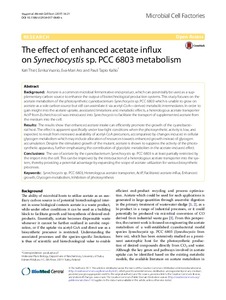The effect of enhanced acetate influx on Synechocystis sp. PCC 6803 metabolism
Kati Thiel; Eerika Vuorio; Eva-Mari Aro; Pauli Tapio Kallio
The effect of enhanced acetate influx on Synechocystis sp. PCC 6803 metabolism
Kati Thiel
Eerika Vuorio
Eva-Mari Aro
Pauli Tapio Kallio
BIOMED CENTRAL LTD
Julkaisun pysyvä osoite on:
https://urn.fi/URN:NBN:fi-fe2021042716743
https://urn.fi/URN:NBN:fi-fe2021042716743
Tiivistelmä
Background: Acetate is a common microbial fermentative end-product, which can potentially be used as a supplementary carbon source to enhance the output of biotechnological production systems. This study focuses on the acetate metabolism of the photosynthetic cyanobacterium Synechocystis sp. PCC 6803 which is unable to grow on acetate as a sole carbon source but still can assimilate it via acetyl-CoA-derived metabolic intermediates. In order to gain insight into the acetate uptake, associated limitations and metabolic effects, a heterologous acetate transporter ActP from Escherichia coli was introduced into Synechocystis to facilitate the transport of supplemented acetate from the medium into the cell.Results: The results show that enhanced acetate intake can efficiently promote the growth of the cyanobacterial host. The effect is apparent specifically under low-light conditions when the photosynthetic activity is low, and expected to result from increased availability of acetyl-CoA precursors, accompanied by changes induced in cellular glycogen metabolism which may include allocation of resources towards enhanced growth instead of glycogen accumulation. Despite the stimulated growth of the mutant, acetate is shown to suppress the activity of the photosynthetic apparatus, further emphasizing the contribution of glycolytic metabolism in the acetate-induced effect.Conclusions: The use of acetate by the cyanobacterium Synechocystis sp. PCC 6803 is at least partially restricted by the import into the cell. This can be improved by the introduction of a heterologous acetate transporter into the system, thereby providing a potential advantage by expanding the scope of acetate utilization for various biosynthetic processes.
Kokoelmat
- Rinnakkaistallenteet [27094]
